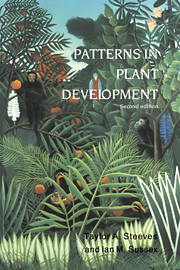Book contents
- Frontmatter
- Contents
- Preface
- Acknowledgments
- 1 Development in the vascular plants
- 2 Embryogenesis: beginnings of development
- 3 Analytical and experimental studies of embryo development
- 4 The structure of the shoot apex
- 5 Analytical studies of the shoot apex
- 6 Experimental investigations on the shoot apex
- 7 Organogenesis in the shoot: leaf origin and position
- 8 Organogenesis in the shoot: determination of leaves and branches
- 9 Organogenesis in the shoot: later stages of leaf development
- 10 Determinate shoots: thorns and flowers
- 11 The development of the shoot system
- 12 The root
- 13 Differentiation of the plant body: the origin of pattern
- 14 Differentiation of the plant body: the elaboration of pattern
- 15 Secondary growth: the vascular cambium
- 16 Secondary growth: experimental studies on the cambium
- 17 Alternative patterns of development
- Credits
- Author index
- Subject index
1 - Development in the vascular plants
Published online by Cambridge University Press: 21 December 2009
- Frontmatter
- Contents
- Preface
- Acknowledgments
- 1 Development in the vascular plants
- 2 Embryogenesis: beginnings of development
- 3 Analytical and experimental studies of embryo development
- 4 The structure of the shoot apex
- 5 Analytical studies of the shoot apex
- 6 Experimental investigations on the shoot apex
- 7 Organogenesis in the shoot: leaf origin and position
- 8 Organogenesis in the shoot: determination of leaves and branches
- 9 Organogenesis in the shoot: later stages of leaf development
- 10 Determinate shoots: thorns and flowers
- 11 The development of the shoot system
- 12 The root
- 13 Differentiation of the plant body: the origin of pattern
- 14 Differentiation of the plant body: the elaboration of pattern
- 15 Secondary growth: the vascular cambium
- 16 Secondary growth: experimental studies on the cambium
- 17 Alternative patterns of development
- Credits
- Author index
- Subject index
Summary
The vascular plant, like all sexually reproducing organisms, begins its existence as a single cell, the fertilized egg or zygote. Proliferation of this cell leads to the formation of an embryo within which, at an early stage, organs and tissues begin to be formed. Early in embryogeny two distinctive regions are set apart, approximately at opposite poles, that subsequently retain the capacity for continued growth. One of these, designated the shoot apical meristem, functions to produce an expanding shoot system by the continued formation of tissues and the initiation of a succession of leaf and bud primordia. The other, the root apical meristem, similarly forms an expanding root system. Furthermore, the development of these open-ended systems is repetitive; the same kinds of tissues and organs are produced in continuing succession.
The activity of the apical meristems results in the production of a continuously elongating body, which has been called the primary body of the plant. In many cases this primary body constitutes the whole plant. In other cases, particularly in those plants with an extended lifespan, there is an additional component of development that leads to an increase in girth of the axis. This results from the activity of two additional meristems that are initiated in the postembryonic stage: the vascular cambium, which contributes additional cells to the conducting system, and the cork cambium, which produces a protective tissue replacing the original epidermis.
- Type
- Chapter
- Information
- Patterns in Plant Development , pp. 1 - 5Publisher: Cambridge University PressPrint publication year: 1989

